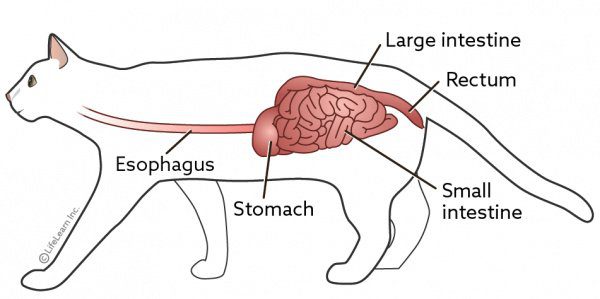Constipated cat: all about cat constipation
The presence of regular transit is one of the signs to watch out for in our four-legged friends. In case of slowing down or even stopping of transit, the animals are said to be constipated. It is a syndrome, relatively common in cats, which is often benign but which should not be neglected.
What are the signs of constipation?
Constipation is the decrease in the frequency of bowel movements. It is often accompanied by difficulty or pain during defecation. The stools can then be small or have a very dry appearance.
A constipated cat will go back and forth in the litter box with no results. He may suddenly have fecal dirtiness, which means getting into position and attempting to defecate outside of his litter box. He can feel pain during his emotional efforts and meow.
Vomiting may also appear, especially in advanced cases. In some cats, it may be observed that their belly is swollen or tense.
Warning: the signs described above (going back and forth in the litter box, getting into position without results) may appear in the event of urinary disorders. It can be a life-threatening emergency if your cat suffers from a urinary obstruction. So check that your cat continues to urinate regularly and if in doubt contact your veterinarian.
Constipation can be due to many causes
Constipation is often related to the cat’s diet and lifestyle, but not only.
There are many causes of constipation. However, it is important to remember these easy-to-identify contributing causes:
- sedentary lifestyle: sufficient regular activity helps to maintain good transit;
- obesity: being overweight also promotes constipation;
- age: for several reasons, older cats tend to have more constipation.
Other environmental causes can trigger constipation.
Hygiene and accessibility of litter
Litter box hygiene is very important for cats who can hold back if they find it dirty. A poorly placed litter box can also create reluctance to have a bowel movement: be sure to put it in a quiet place, without unpredictable noise (such as a washing machine for example) and without too regular passage.
Insufficient water supply
A dehydrated animal will tend to have drier stools that are more difficult to pass. This is especially true in cats who tend to not drink enough.
A partly wet diet thus promotes better transit than a dry diet.
Heavy ingestion of hair
A recurring problem in long-haired breeds that ingest hair while grooming. The hairs are not digested and create plugs which slow down the transit by binding the stools together.
Other pathologies
Many pathologies can also create disorders in the functioning of the digestive tract and create constipation: digestive obstructions, megacolon, chronic dehydration, etc.
It is important to establish an accurate diagnosis
If your cat is constipated, it is important to present it to your veterinarian. Faced with the large number of causes that can create this syndrome, an accurate diagnosis is essential to implement an appropriate treatment. You must also be reactive, the sooner the constipation is taken care of, the less complex it will be to treat.
To determine the cause of constipation, your veterinarian will perform a complete clinical examination of your cat. If necessary, he will suggest additional examinations (x-rays, blood tests) to assess the severity of the constipation or to certify the presence of an underlying disease.
For simple cases, oral or rectal medical treatment may be sufficient. For more advanced cases, hospitalization with an infusion to rehydrate the animal may be necessary. If very hard stools have formed in the cat’s intestine (faecal impaction), a rectal enema under general anesthesia is often performed.
Conditions like megacolon require surgery to permanently treat the condition.
Some solutions to implement at home
If you know the cause of your cat’s constipation, several solutions exist to facilitate its transit:
- Increase the water intake in his ration: increase the number of water bowls and by varying their nature and location. Consider using a water cooler if your cat likes running water. You can also include wet food in his daily ration;
- Increase activity: leave toys so that he can exercise when he wants. Also remember to play with him regularly;
- Monitor his weight: talk to your veterinarian about solutions to gradually reduce your cat’s weight if he is overweight;
- Food and treatments to facilitate transit: there are hyperdigestible foods that promote transit by reducing the amount of stool;
- It is also possible to administer oral treatments to facilitate the transit of cats. Paraffin-based laxatives are used to lubricate the stool in the digestive tract to facilitate their passage. Others will increase the water content in the stool as do compounds containing psyllium.
Ask your vet for advice on using the right treatment for your cat.
What to remember?
A disease with a mild appearance, constipation can be a manifestation of more serious conditions. If you know the cause of constipation, there are some things you can do at home. But in case of doubt, a consultation with a veterinarian will allow you to detect the cause of constipation and to implement the appropriate treatment.










